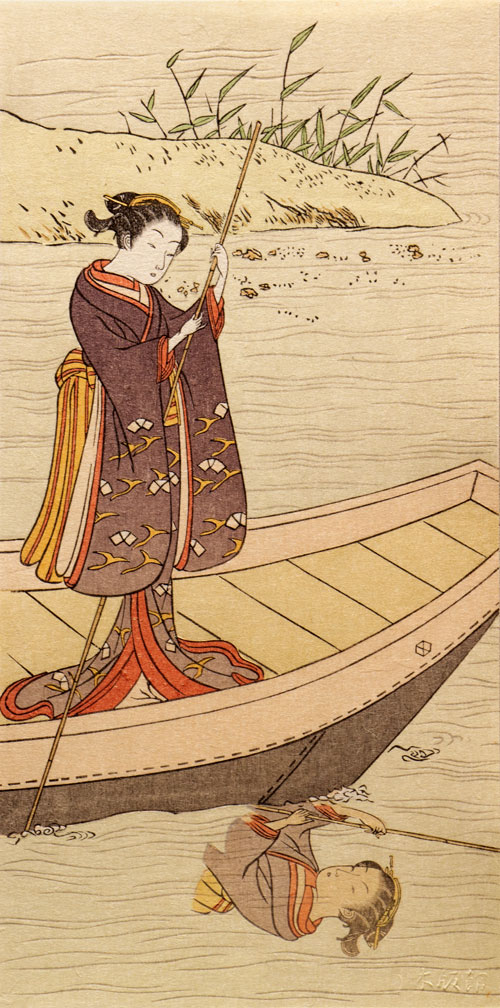Dharma Crossing the Yangtze (揚子江を渡る達磨) Designer: Suzuki Harunobu | Carver: David Bull | Printer: Kenichi Kubota Paper size: 22.5cm by 10.5cm | Enlargement | Shipping Code: [M] ? ( Change currency: $ / £ / € ) Price: $ 75.00£ 60.75€ 69.00   Description: Harunobu’s designs are of course all quite ‘pretty’, and I am sometimes quite puzzled just why we should think so. The drawing is hopelessly unrealistic, and the basic human proportions are wildly distorted - look at the size of her right hand compared to her overall height, or the size of the mouth compared to the overall face. How on earth can we the viewers ever think that such grotesque distortion of a figure is attractive? Was Harunobu an incompetent artist? Incompetence obviously isn’t the question, but rather how much any given artist is ‘allowed’ to create for himself, and how much he must adopt from his predecessors. The men before Harunobu drew hands and mouths that way, and he simply accepted ‘that’s the way it is’ and drew his figures in a similar way. Indeed, this standardized ukiyo-e portrait, with the simple hook nose, the tiny mouth, and the shrunken hands, lasted for hundreds of years, evolving only slightly as it went along, and its successor can still be found in contemporary manga illustration. Well, if you hadn’t been worried about the ‘bad’ draftsmanship, perhaps you were wondering about just what a young woman in elegant kimono is doing poling a heavy boat down a stream ... Surely we are not expected to believe that she could do this while dressed that way? Again, realism has nothing to do with this print. In Harunobu’s day, an image like this was in no way intended to be a depiction of an actual event. We are supposed to look at the picture, and recognize the literary allusion that it represents. Harunobu was a master at this sort of ‘puzzle’, and his Zashiki Hakkei, in which eight domestic scenes represent eight traditional landscapes, is considered the masterpiece of the genre. Viewers of Harunobu’s day apparently had no trouble recognizing such allusions based on their knowledge of classical literature, and I suspect that they wouldn’t have thought of this as a ‘puzzle’ at all. But for me, with a poor knowledge of Chinese classics, it was necessary to ‘call for help’. I posted a message to an internet group that studies ukiyo-e, and soon received a reply from a scholar in the US. He pointed out that the image represents the well known episode ‘Dharma crossing the Yangtze’. He even showed me another version of the print, in which the girl is actually accompanied in the boat by Dharma. Once I saw this, I realized that the solution to the puzzle should have been obvious - Harunobu even left a large hint in the up-turned shape of the prow, which mirrors the shape of the leaf on which the crossing was supposed to have been made. Well, I failed the test this time, but perhaps next time I’ll get it!    Browse thumbnail pages of various selections from the catalogue ... Mokuhankan Publications:general (104) kacho-e (27) landscape (54) bijin-ga (19) contemporary (17) senshafuda (2) yakusha-e (4) HangaClub (70) ebook (6) miscellaneous (4) 8 Cats (4) supplies (6) [ Also see our Annual Gift Page ] Partner Shops: Kawase Hasui prints (14) Yoshida family prints (51) Doi Hanga prints (15) Miyakodori prints (11) Numabe Mokuhan prints (3) Guest items (17) Mokuhankan Flea Market (All items) general (67) kacho-e (35) yakusha-e (24) landscape (130) bijin-ga (85) kuchi-e (2) contemporary (4) set (43) books (4) (Recently sold items) |
||